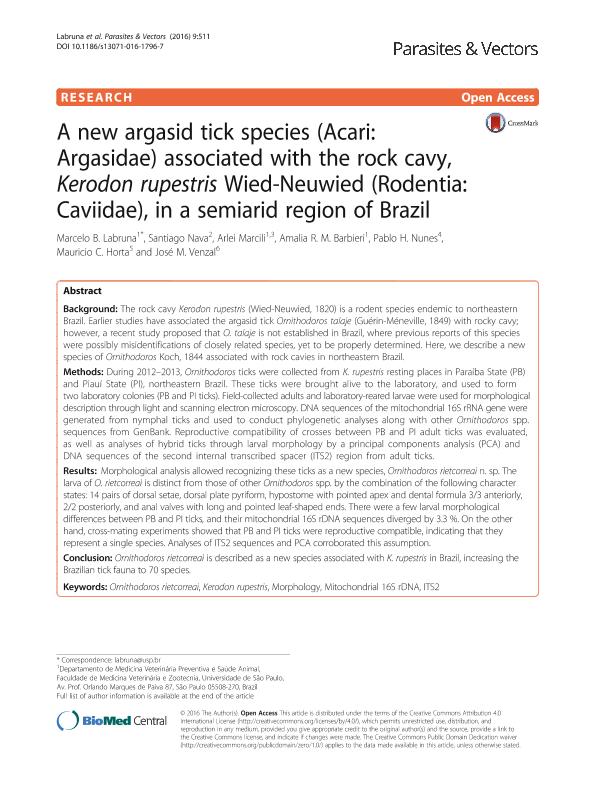Artículo
A new argasid tick species (Acari: Argasidae) associated with the rock cavy, Kerodon rupestris Wied-Neuwied (Rodentia: Caviidae), in a semiarid region of Brazil
Labruna, Marcelo B.; Nava, Santiago ; Marcili, Arlei; Barbieri, Amalia R. M.; Nunes, Pablo H.; Horta, Mauricio C.; Venzal, José M.
; Marcili, Arlei; Barbieri, Amalia R. M.; Nunes, Pablo H.; Horta, Mauricio C.; Venzal, José M.
 ; Marcili, Arlei; Barbieri, Amalia R. M.; Nunes, Pablo H.; Horta, Mauricio C.; Venzal, José M.
; Marcili, Arlei; Barbieri, Amalia R. M.; Nunes, Pablo H.; Horta, Mauricio C.; Venzal, José M.
Fecha de publicación:
09/2016
Editorial:
BioMed Central
Revista:
Parasites and Vectors
e-ISSN:
1756-3305
Idioma:
Inglés
Tipo de recurso:
Artículo publicado
Clasificación temática:
Resumen
Background: The rock cavy Kerodon rupestris (Wied-Neuwied, 1820) is a rodent species endemic to northeastern Brazil. Earlier studies have associated the argasid tick Ornithodoros talaje (Guérin-Méneville, 1849) with rocky cavy; however, a recent study proposed that O. talaje is not established in Brazil, where previous reports of this species were possibly misidentifications of closely related species, yet to be properly determined. Here, we describe a new species of Ornithodoros Koch, 1844 associated with rock cavies in northeastern Brazil. Methods: During 2012-2013, Ornithodoros ticks were collected from K. rupestris resting places in Paraíba State (PB) and Piauí State (PI), northeastern Brazil. These ticks were brought alive to the laboratory, and used to form two laboratory colonies (PB and PI ticks). Field-collected adults and laboratory-reared larvae were used for morphological description through light and scanning electron microscopy. DNA sequences of the mitochondrial 16S rRNA gene were generated from nymphal ticks and used to conduct phylogenetic analyses along with other Ornithodoros spp. sequences from GenBank. Reproductive compatibility of crosses between PB and PI adult ticks was evaluated, as well as analyses of hybrid ticks through larval morphology by a principal components analysis (PCA) and DNA sequences of the second internal transcribed spacer (ITS2) region from adult ticks. Results: Morphological analysis allowed recognizing these ticks as a new species, Ornithodoros rietcorreai n. sp. The larva of O. rietcorreai is distinct from those of other Ornithodoros spp. by the combination of the following character states: 14 pairs of dorsal setae, dorsal plate pyriform, hypostome with pointed apex and dental formula 3/3 anteriorly, 2/2 posteriorly, and anal valves with long and pointed leaf-shaped ends. There were a few larval morphological differences between PB and PI ticks, and their mitochondrial 16S rDNA sequences diverged by 3.3 %. On the other hand, cross-mating experiments showed that PB and PI ticks were reproductive compatible, indicating that they represent a single species. Analyses of ITS2 sequences and PCA corroborated this assumption. Conclusion: Ornithodoros rietcorreai is described as a new species associated with K. rupestris in Brazil, increasing the Brazilian tick fauna to 70 species.
Archivos asociados
Licencia
Identificadores
Colecciones
Articulos(CCT - SANTA FE)
Articulos de CTRO.CIENTIFICO TECNOL.CONICET - SANTA FE
Articulos de CTRO.CIENTIFICO TECNOL.CONICET - SANTA FE
Citación
Labruna, Marcelo B.; Nava, Santiago; Marcili, Arlei; Barbieri, Amalia R. M.; Nunes, Pablo H.; et al.; A new argasid tick species (Acari: Argasidae) associated with the rock cavy, Kerodon rupestris Wied-Neuwied (Rodentia: Caviidae), in a semiarid region of Brazil; BioMed Central; Parasites and Vectors; 9; 1; 9-2016; 511
Compartir
Altmétricas



